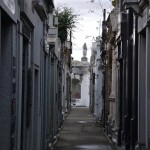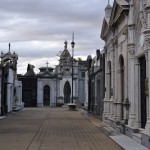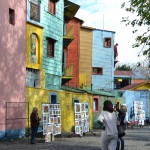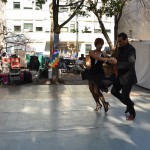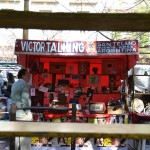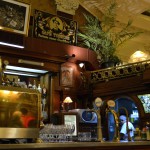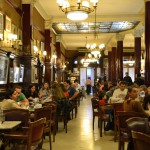After a red-eye overnight flight from Bogotá to Santiago de Chile and a connecting flight to Buenos Aires, we were quite exhausted when we arrived there in the early afternoon. At least, thanks to hotel loyalty points accumulated on too many work trips, we were able to stay at a very nice hotel right in the center of town. In the evening, we did still explore the area around the hotel somewhat, including the beautiful former harbor area (now residential) of Puerto Madero, but we didn’t make it all the way to Argentinian dinner time – which is typically around 10pm!
The next day, after a relaxing long night of sleep, we walked through the the city to explore the different areas. Besides Microcentro, which is the are where our hotel was located as well as many shopping streets, on this first day we also went to La City as well as Recoleta. La City is centered around Plaza de Mayo, which houses many important buildings, including the “Pink House”, seat of the president, as well as the cathedral, former seat of current pope Francis. The “Pink House” we could even visit from the inside, since it was the weekend, which was nice. Also around the plaza, there are many nice old and grand buildings, so it was very pleasant to explore the city.
In Recoleta, we went to see the very impressive old cemetery. Beyond the tomb of Eva “Evita” Peron, the cemetery features some other important Argentinians, but is mostly an attraction for the large number of very impressive old tombs and mausoleums.
In the evening, we went for dinner and drinks in Palermo. First, we had some Argentinian meat at Don Julio. This country being one of the world’s best sources for beef, we had high expectations, and we’re not disappointed: the steak and the chorizo were definitely both excellent. Afterwards, we had cocktails at the cocktail club “Verne” – which was unfortunately really full so we didn’t get a table for the whole time we were there.
On Sunday, we went to La Boca and San Telmo. La Boca is a very rough, blue-collar neighborhood, and famous for its colorfully painted houses by the riverside. Originally, this colored paint used to be leftover paint from ships that the residents used to paint their houses. Today, however, it is evidently more for the tourists. We had read this on the internet before coming, but still wanted to see for ourselves. Unfortunately, it is true – the few streets along the river are full of cheap tourist crap and restaurants, and hundreds of touts trying to sell you things. We escaped as fast as we could.
Instead, we went to San Telmo, which was very nice – there are many antique stores there, and on Sundays, there is also a huge outdoor flea market on the streets – partly with cheap souvenirs, but partly also interesting second hand and antique goods. I was most intrigued by a stall with old, working gramophones that the seller was demonstrating – quite amazing how without any electric power these things still produce quite a bit of volume! After the market, we went to Costanera Sur to look for street food. Costanera Sur is a boardwalk behind the coastal ecological reserve, and clearly the weekend destination mostly for Buenos Aires residents – hardly a tourist in sight. Instead, there was one food stall next to the other, and we got to try some amazing things like Choripan – basically chorizo sausage on bread. (In terms of street food, it didn’t beat Arepa con Queso though).
On the way back to the hotel, we still went to Cafe Tortoni. The cafe is definitely a tourist attraction, but still worth a visit – it opened in 1856, and not just its age is impressive, but also the interior decoration. It is definitely a very grand cafe, with beautiful wood paneled walls and stained glass windows on the ceiling. The coffee was not the best I ever had, but that was maybe not that surprising.
A few more interesting points about Buenos Aires: firstly, about money. In contrast to most other countries, exchanging or withdrawing money, or paying by credit card, will not get you the most for your money. The reason is that while the Argentinean peso has a fixed exchange rate to the dollar (when we came, about 9 pesos to the dollar), due to exchange controls most Argentinians cannot legally exchange their pesos for dollars. Due to rampant inflation (about 20-25%), however, many of them do want to convert their pesos to hard currency. This has led to the emergence of a “blue” market of – illegal, but tolerated – exchange offices, where a dollar will buy you more than 12 dollars. Even just paying in USD cash rather than pesos at a restaurants will many times give you a better rate than the official one.
Secondly, the influence of Italian immigrants – most notable in the existence of a large number of ice cream parlors in the city, many of which are very good. Another effect seems to be the color of the Argentinean Spanish – it also sounds like people are speaking Italian, but they happen to use Spanish words.
Lastly, one point about safety: especially in contrast to Bogotá, Buenos Aires seemed much safer, especially with respect to violent crime. Pick pocketing seems to be a risk, but that is probably true in most other big cities, but at least we didn’t feel so afraid to potentially get mugged when walking around.
On Monday morning, we left Buenos Aires again for Chile, to fly via Santiago to San Pedro de Atacama.
Some pictures follow.
- Recoleta cemetery
- Recoleta cemetery
- La Boca
- Street tango
- San Telmo antique fair
- Cafe Tortoni
- Cafe Tortoni
Tags: Argentina, Buenos Aires, Honeymoon
